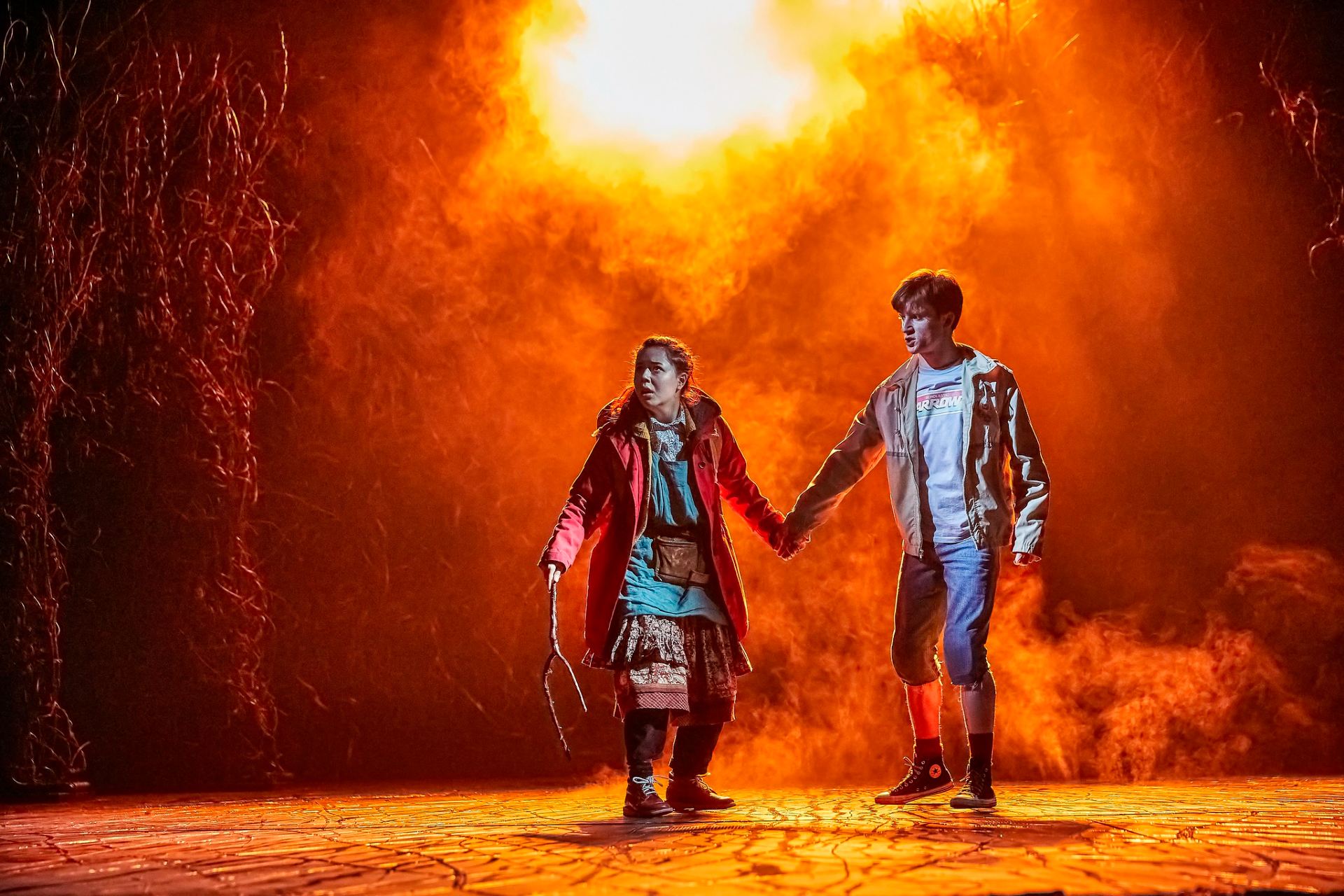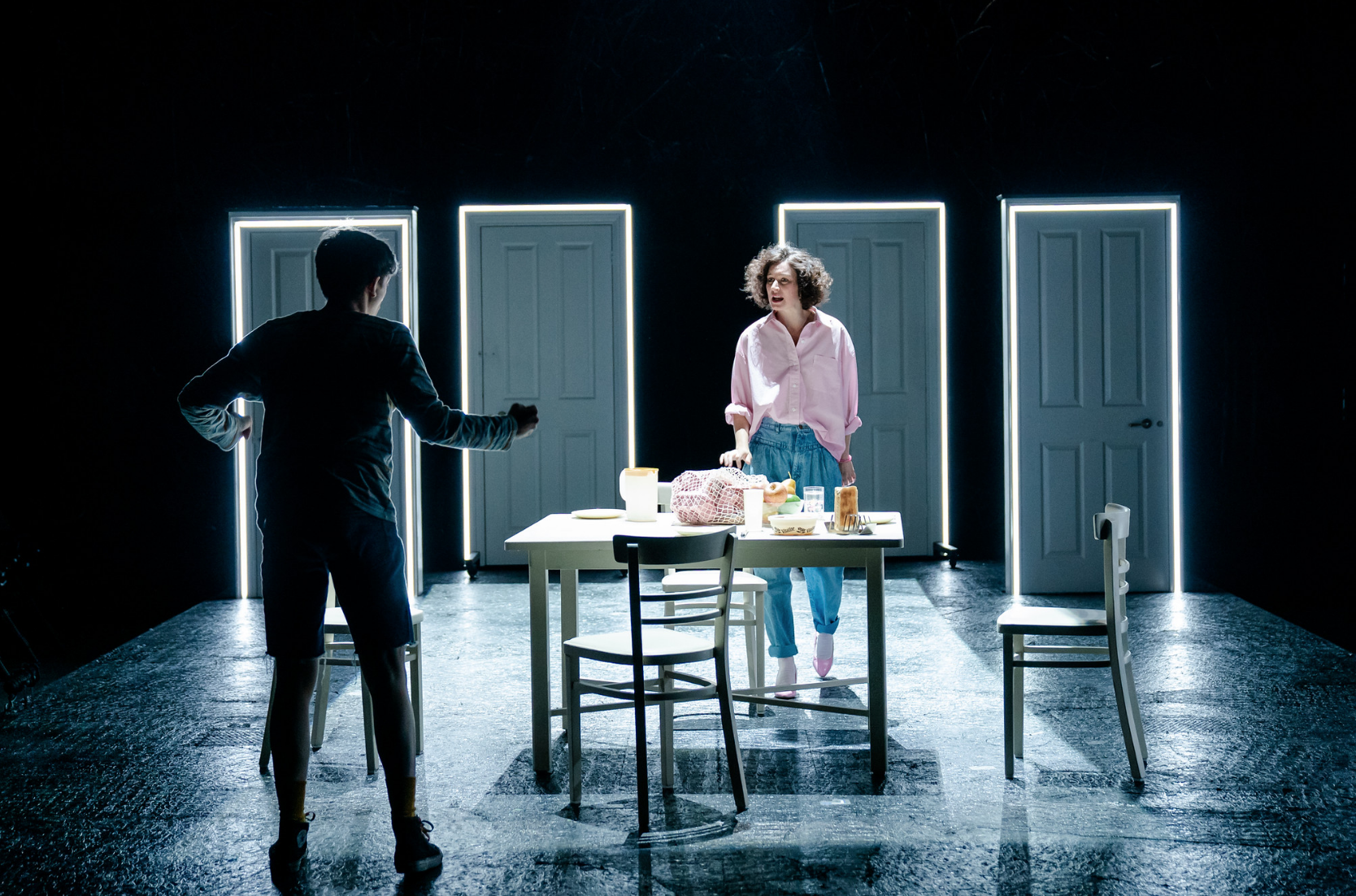
Adapted from Neil Gaiman’s 2013 best-selling novel; this stage adaptation of The Ocean At The End Of The Lane brings jaw-dropping special effects, illusions and spine-chilling performances and adapts the imagination of readers into a spellbinding phenomenon, that any fans of pop culture pieces such as Stranger Things or Harry Potter will adore. Directed by Katy Rudd, this thrilling piece of fantasy takes strong moral themes of: fantasy, friendship and myth and morphs them into a theatrical spectacle.
The narrative is set primarily in 1983 and tells the story of an unnamed individual, simply referred to as ‘The Boy’ (Keir Ogilvy), who returns to his childhood home for his father’s funeral; finds himself standing beside the pond of the old Sussex farmhouse where he used to play. Upon returning to this impactful relic of times gone by, he is reminded of his past–of a girl called Lettie Hempstock (Millie Hikasa) and the otherworldly events that unfolded merely days after his 12th birthday. The beauty of the show, with directorial impact from Rudd, allows such a narrative to unfold that the audience is transported into The Boy’s mind and how he recalls his days with Lettie. The pond wasn’t just a pond, but an ocean–a place where everything and anything is possible.
The story is packed full of utter suspense, with The Boy’s mind becoming a void of possibility; that’s a mix of terrifying incidents and true heartwarming moments of friendship. With the imagination of a child at the forefront of this production; with The Boy using reading as a means of comfort, both Gaiman and Rudd allow this to become a space that’s manipulated, allowing something…or someone, more sinister, to enter into our realm. I can’t recall the last show that left me on the edge of my seat–but The Ocean At The End Of The Lane most definitely achieved this in such a way that evoked me in the most unexpected of ways.

Keir Ogilvy fronted the cast as The Boy, portraying all of the emotions, fears and worries a 12-year-old would be having when having to face ancient forces that threaten to destroy everything around him. The role of The Boy is an incredibly challenging one, having many relationships to maintain, with his Father (Trevor Fox), Sister (Laurie Ogden) and new-found friend Lettie; all of whom if he didn’t have, would be left with nothing. Both emotionally and physically, Ogilvy’s character is one you root for from the very beginning–with the production opening with The Boy having to witness a suicide; it seems like he’s been cursed with misfortune, with this strong moral feeling growing as he’s faced with a magical world that brings danger directly to his family. Nevertheless, The Boy accepts his fate; battling with both the harsh truth of reality and this whole new world that’s been opened to him by Lettie, with Ogilvy performing this throughout in such a way that leaves you captivated by his performative nature.
Within the cast of The Ocean At The End Of The Lane, it’s nearly impossible to pick a favourite performer, with the entire cast and crew coming together to create a truly magical spectacle like nothing I’ve ever seen before. Millie Hikasa joins forces with Ogilvy, with this bond between Lettie and The Boy creating some truly heartwarming moments. From the get-go; she’s there to protect him, creating a feeling of two-lost souls who have found their match. Being a part of the mystical Hempstock family, she informs The Boy that she’s a similar age to him–but in reality, she’s much older; but still has a childhood whimsical charm about her. Hikasa is an actress who’s bouncy, playful and packed full of energy, but she’s also strong-willed with protective morals; protecting The Boy at all costs, with the unpredictable future of strange beings and new worlds unfolding in front of them. Joining forces to battle against these dark realms, both Ogilvy and Hikasa create a fantastic duo; with an undeniable alliance between them.
Arguably the biggest name within the production is Charlie Brooks; known in the public eye for her work on Eastenders, joining the cast as the devious Ursula/Skarthach. Throughout the narrative, we’re warned by the Hempstock family of the otherworldly beings known as ‘fleas’. Attempting to enter our reality using tactics of persuasion, Brooks as Skarthach coaxes The Boy into allowing her to bypass into our realm of existence, where she shapeshifts into the perfectly prim Ursula; inserting herself into The Boy’s life by becoming his father’s new lodger. With a driving motivation of making everyone happy, Ursula is a simple creature–but when her morals are thwarted by Lettie and The Boy; she’s no longer concerned with happiness. She’s now concerned with doing anything to stay in this new life she’s created for herself and is determined to do some malicious things to get there. Brooks plays the role of Ursula chillingly well, with the audience never knowing what’s coming next with her misguided morals. It’s an extremely difficult role to play, being the antagonist in The Boy’s mind full of fairy tales; but Brooks pulls it off with a devilish grin, bringing a frightfully good Ursula from page to stage.
The Ocean At The End Of The Lane is a play that allows the collective ensemble to become a vital piece of narrative storytelling. All being dressed in black, the creative crew come together to seamlessly move set, and act as key pieces of movement for the main cast; especially in a scene where The Boy flees home, seeking refuge away from Ursula with Lettie; where he’s tumbling, jumping and exploring the woods and also assist with puppetry. Without the addition of this collective crew; alongside each of the talented actors and actresses with speaking roles, some of the most beautiful scenes that unfolded on stage couldn’t have been achieved.

The use of puppetry, implemented by puppetry director Finn Cadwell, was visually stunning. In both iterations where this performative nature was used; they acted as polar opposites of one another; initially used to create a truly impactful fearful scene and later in the second act to form a visually stunning safe haven for The Boy and Lettie. Cadwell’s puppetry really shined when Skarthach is first introduced to the audience–with a spider-like body and multiple draped cloths portraying a decaying circus tent, the flea is portrayed in such an abstract form that we can’t quite tell what she is. She’s gruesome, and decaying, taking up an immense stage presence, making Lettie and The Boy seem tiny compared to her monumental impact. When she first entered the stage; I felt shivers go through my entire body, and I could tell other audience members were in terrified awe of this amazing feat of puppetry.
This creative direction from Cadwell was also visually stunning when The Boy and Lettie physically enter the ocean; as a safe haven to escape the looming dark forces. Small puppets of the duo have been created especially for this scene; as the duo swim and dance around the stage; with the mini versions of them illuminating as we see the true good inside of them. This was a scene that once again gave me chills; not because of fear this time, but because of how visually stunning and heartwarming this scene was.
The creative direction of the production was phenomenal; as expected from a National Theatre production. Set design from Fly Davis truly supported the narrative storytelling; with the woods staying as a backdrop for every location; making you feel like you’re always between the lines of safety and danger, reality and imagination. The dark, twisted branches are beneficial when creating the illusion of the countryside; allowing the audience to be fully immersed in the narrative. The Boy’s home feels quite bare but modern, in terms of the production being set in 1983, with rooms being created by pulling household items such as a bathtub, beds and tables onto the stage to create each room of his residence. The Hempstock’s home is in complete parallel to this, feeling disorganised, cluttered and old. But with this clutter comes magic and inspiration, as the family unit has potentially lived together for centuries and is well-established within their farmhouse, having a real sense of ownership of their land.
Davis’ set design paired outstandingly well with lighting design from Paule Constable; especially with the use of multiple doorways within The Boy’s home–which were illuminated with white LEDs making them almost look like portals that had come from another realm. This idea of portals was used in a jaw-dropping scene; within which Ursula manipulates the realms of reality, creating several pathways; locking each one as she does so, in order to ensure that The Boy has no means of escape. As the doors seem to magically multiply; we’re treated with Ursula’s chilling laughter echoing through the theatre, elevated by Ian Dickinson’s sound design; which also makes great use of 80’s synth tracks to engage the audience. Within Constable’s lighting design, the use of strobe lighting to create a feeling of distress; alongside the utilisation of spotlights were true feats of talent.

Through the collaborative nature of: Davis and Constable; the simple utilisation of doorways became a key aspect of the performance, with the white hues changing to pink when Ursula was in ultimate control of the house. With pink being a feminine tone, this was a colour that instantly became associated with her devious character, wearing a signature set of baby pink heels to match her prim persona. With Ursula in control; the use of illusions, created by Jamie Harrison was truly jaw-dropping–these techniques were used several times to prove her otherworldly capabilities, seemingly appearing from nowhere and being able to manipulate space and time; reaching her hand through a seemingly solid wood door to obtain The Boy’s keys to his room, therefore taking complete control, gaining access to his key place of privacy.
Reflecting back upon these techniques, I’m still baffled by how many of them were achieved; with high collective praise going to the entire creative cast behind this truly mind-blowing production.
Whether you’re familiar with Neil Gaiman’s original novel, or if you’re completely new to this spellbinding narrative, The Ocean At The End Of The Lane is truly mystifying; forever leaving you guessing. The imagination of The Boy, created for an on-stage spectacle truly shouldn’t be missed whilst it’s running at the Theatre Royal Plymouth. As the story is recounted in the present day, with jaw-dropping, show-stopping visuals and magical performances from the entire cast; you’ll find yourself in a whirlwind of emotions as you leave questioning “Where does imagination stop and reality begin?”
★★★★★
